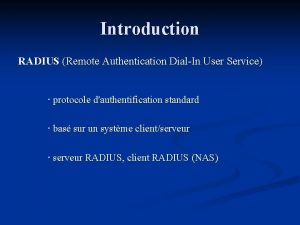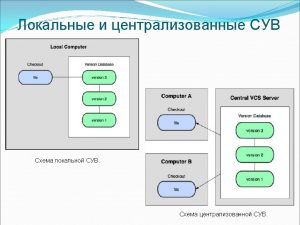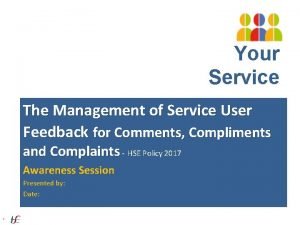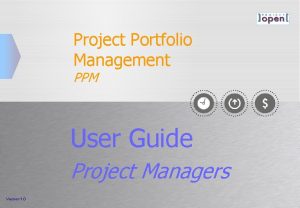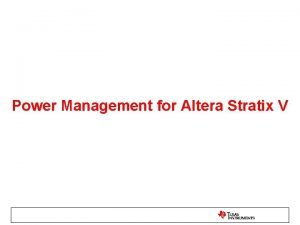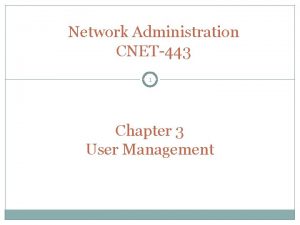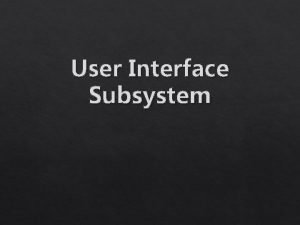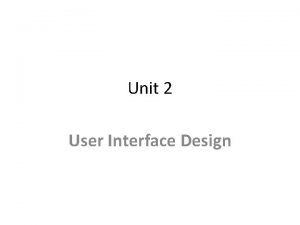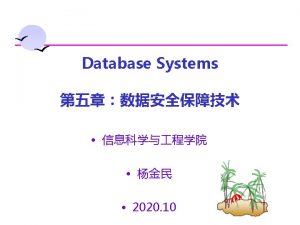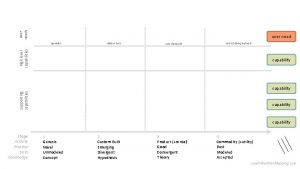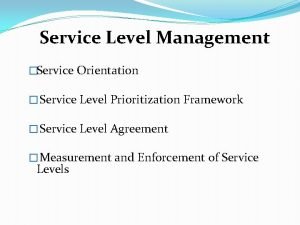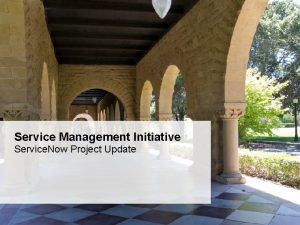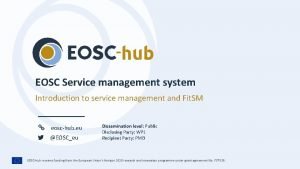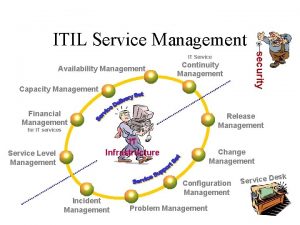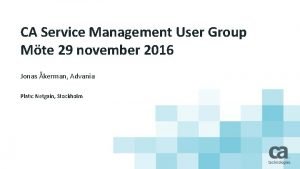Your Service Your The Management of Service User


























































- Slides: 58

Your Service Your The Management of Service User. Say Feedback for Comments, Compliments and Complaints - HSE Policy 2017 Awareness Session Presented by: Date: 1

Background to YSYS Revision Your Service Your Say is the HSE national standard procedure for managing service user feedback Ombudsman’s Report: The main barriers to giving feedback or making a complaint were identified by participants as: –A fear of repercussions for their own or their relatives’ treatment –A lack of confidence that anything would change as a result of complaining 2

Main changes • Governance changes (Complaints Managers, CHO and HG responsibilities) • Emphasis on Learning • Casebooks • No Wrong Door • Emphasis on resolution at first point of contact • Development of Complaints Management System • Development of e. Learning Training Tools • Revised Standardised Letters and Report Template • Complaints Officers must make Recommendations 3

Guiding Principles of the revised Policy 4

‘No Wrong Door’ Approach • All staff are encouraged to accept feedback and make an attempt to assist the service user. • Having a ‘No Wrong Door’ approach ensures that wherever a complaint is raised, it is the relevant staff and not the service user that is responsible for routing it to the appropriate place for response. 5

How to provide Feedback? • Tell a staff member. All staff are encouraged to accept feedback – no wrong door approach. • Ask a member of staff for details of where to send a letter which sets out your experience of our services. • Email your feedback to yoursay@hse. ie • Complete a Feedback Form and leave it in the identified areas provided by the local service you are using or visiting. You may also give it to a member of staff or ask a staff member for an address. • You can use the website feedback facility at the following address: www. hse. ie/feedback • Telephone us on: – YOURSAY Team: 1890 424 555 (Monday to Friday: 9 am – 5 pm). If telephoning from a mobile please contact: 045 880400, to avoid additional charges. – HSE Live Team: 1850 241 850 (Monday to Friday: 8 am to 8 pm, Saturday : 10 am – 5 pm) 6

nts e m i l Comp Comments and Compliments Comm ents • A comment is a verbal or written remark expressing an opinion or reaction. • A compliment is an expression of praise, commendation or admiration. Learning from Positive Experiences It is recommended that good patient experience and compliments received should be promoted and reported across all services within the HSE. 7

YSYS - Support • A comprehensive Guidance Manual on the revised Your Service Your Say Policy and other supporting documentation including letter and report templates is available online from www. hse. ie/yoursay • Local Consumer Affairs Office can offer advice and assistance. • Each CHO and Hospital Group has a Complaint Manager in place to be a champion for the feedback process though an active and visible leadership role with key involvement in education, training and reporting arrangements. • Online E-Learning HSEland Modules • Complaints Manager Forum

Other documents include

10

NEW YSYS – Learning Dual Purpose Point of Contact Complaints Resolution & Escalation Form Point of Contact Complaints Resolution Form – To be completed by: Any staff member who has resolved a service user’s complaint at point of contact. Send to Line Manager. Point of Contact Complaint Escalation Form – To be completed by: Line Managers who are unable to resolve a complaint at the point of contact.

NEW YSYS - Learning, Improving and Accountability Complaints Officers • Complete an anonymised learning notification form following a complaint investigation only in cases where learning has been identified. Send to Complaints Manager for circulation. • Generate a quarterly anonymised learning summary (casebook) on the complaints investigated highlighting learning that have relevance for the wider organisation. Send to Complaints Manager for appropriate circulation and also share at the Complaints Officer Forum Review Officers • Complete an anonymised learning notification form following a complaint review only in cases where learning has been identified. Send to Complaints Manager for circulation.

Your Service Your Say Complaints Management 13

Definition of a Complaint (Health Act 2004) “A complaint means a complaint made about any action of the Executive, or a Service Provider that, it is claimed does not accord with fair or sound administration practice, and adversely affects the person by whom, or on whose behalf, the complaint is made”. An action does not represent fair or sound administrative practice if it is: • taken without proper permission or authority, • taken for unnecessary reasons, • the result of negligence or carelessness, • based on incorrect or incomplete information, • discriminatory, • based on bad administrative practice. A complaint is an expression of dissatisfaction which needs a response 14

Who can complain? Any person who has received or sought health or personal social services from the Executive or Service Provider. If a person is entitled to make a complaint but is unable to do so because of age, illness or disability, the complaint may be made on that person’s behalf by: • • • 15 a close relative or carer of the person (parent, guardian, son, daughter or spouse or is cohabiting with the person); any person who legally has the care of the affairs of that person; any legal representative of the person; any other person with the consent of the person; and if a person who would otherwise have been entitled to make a complaint is deceased, a complaint may be made by a close relative or carer of that person.

How can a complaint be made? • The HSE and Service Providers must be flexible in receiving feedback and allow feedback to be received in a way that suits the service user e. g. by letter, e-mail or verbally • Service Users must be allowed the flexibility to lodge a complaint with any staff member…remember the ‘no wrong door’ approach. 16

Updated What is Advocacy? All complainants have a right to appoint an advocate to assist them in making their complaint and to support them in any subsequent processes in the management of that complaint. Advocates help, facilitate, negotiate, defend… Citizens Information Board defines advocacy as “a means of empowering people by supporting them to assert their views and claim their entitlements and where necessary, representing and negotiating on their behalf 17

Matters that are excluded from investigation under Part 9 of the Health Act 2004 In line with best practice, the HSE will investigate every complaint using the complaints procedure, an alternative process or refer it to the appropriate personnel. • • • a matter that is or has been the subject of legal proceedings before a court or tribunal a matter relating solely to the exercise of clinical judgment an action taken by the Executive or a service provider solely on the advice of a person exercising clinical judgment a matter relating to recruitment or appointments a matter relating to or affecting the terms or conditions of a contract of employment a matter relating to the Social Welfare Act a matter that could be the subject of an appeal under Section 60 of the Civil Registration Act 2004 a matter that could prejudice an investigation being undertaken by An Garda Síochana a matter that has been brought before any other complaints procedure established by law e. g. Complaints Process under Part 2 of the Disability Act 2005 However, where a matter is excluded from investigation under Part 9 of the Health Act 2004, using their knowledge Complaints Officers will identify if the complaint should be dealt with by: • using the complaints procedure, • using an alternative process; or • referring it to the appropriate personnel. 18

Time Limits for making a Complaint 19 • To make a complaint Within 12 months • When decision made to extend/not extend 12 months timeframe Within 5 working days

• Inform complainant if complaint does not meet criteria for investigation • Acknowledge receipt of complaint Stage 2: General Timeframes • Investigate and conclude Within 30 working days (of acknowledging complaint) • Update the complainant and relevant staff • Conclude at latest 20 Within 5 working days • Requesting information back from Complainant/Staff member/persons no longer Every 20 working days Within 6 months Within 10 working days

Your Service Your Say Stages of Complaints Management 21

Overview of the Four Stages of Complaints Management 22 22 Stage 1 HSE Point of Contact Resolution Stage 2 HSE Formal Investigation Process Stage 3 HSE Internal Review Process Stage 4 Independent Review

Your Service Your Say Stage 1: HSE Point of Contact Resolution Stage 1 HSE Point of Contact Resolution Complaint resolution at First Point of Contact 23

Point of Contact • All HSE staff must aim to resolve complaints they receive at first point of contact, if possible. • Feedback (Comments, Compliments & Complaints) may be given to any member of staff. • If local staff are unable to deal with this feedback personally they should provide reassurance that it has been listened to, understood and then outline how this feedback will be handled beyond this point. Note: It is important to ensure that Service Users’ immediate healthcare needs are being met, as appropriate, before dealing with the issue. 24

Point of Contact • HSE staff should always respond appropriately – LISTEN* approach • They should acknowledge the feedback in an open and honest way demonstrating empathy and understanding. • Establish what the service user expects from providing their feedback. • Provide an apology/explanation where possible and avoid apportioning blame, being argumentative or defensive. • Some complaints may not be appropriate, due to their nature, to handle at point of contact and may need to be referred on to a line manager, if appropriate. 25

Why Point of Contact Resolution? • Complaints are dealt with directly and quickly where the issues arise. • Little formality as possible. • Prevents issues escalating due to delays or unwillingness to address issues. • Demonstrates proactive response from the service. • Staff empowered to deal with complaints. • Saves time and resources than formal approach. 26

Remember! Don’t Forget Where a staff member has successfully resolved a complaint, at that first point of contact, they must complete a Point of Contact Complaint Resolution Form and send it to their Line Manager! 27

NEW HSELan. D Module 1 Effective Complaints Handling (1 CEU Point)

Effective Communication • Listening • Empathy • Questioning • Body Language • Tone of Voice 29

Active Listening involves: Suspending your own thoughts and judgments, and giving your undivided attention to the speaker • • Being motivated Empathising with our service users Interrupting only when appropriate Paraphrasing and Summarising Taking in the whole picture Asking questions – note taking if appropriate Using positive body language We hear with our ears but listen with our brain. 30

Empathy Put yourself in the other person’s shoes 31

Effective Questioning Ask questions to clarify the complaint: • Ask one question at a time (avoid bombardment) • Use open questions to gather information (Tell me about…what happened, where did it happen, when did it happen…) • • • 32 Use closed questions to clarify detail (so you’re saying…. ) Do not be afraid to ask the same question twice Do not use leading questions Do not express opinions in words or attitudes Try to separate hearsay from fact by asking interviewees how they know a particular fact

Body Language and Tone of Voice 33

LISTEN Approach Listen to the complainant Identify the issues (be aware of multiple issues) and what outcome the complainant would wish to result from their complaint Summarise the issues Thank the complainant Empathise and Explain what the next step is going to be. Now Act - determine the appropriate action. 34

Listening The word LISTEN contains the same letters as the word SILENT - Alfred Brendal 35

Audio option Option here to play the audio from Module 2. The audio is available on the trainers link as a separate file This shows how a Complaints Officer manages to resolve a couple of issues informally over the phone with a complainant. 36

Making an Apology • It is the policy of the HSE that where failures in the delivery of care to a Service User have been identified, these failures must be acknowledged to the Complainant/Service User and a meaningful apology provided. • An apology can be made by any member of staff at any stage of the complaints management process. • Written apologies are recorded on the Complaints Management System. 37

Dealing with Unreasonable Behaviour “Unreasonable complainant conduct is any behaviour by a current or former complainant which, because of its nature or frequency raises substantial health, safety, resource or equity issues for our organisation, our staff, other service users and complainants or the complainant himself/herself. ” (New South Wales Ombudsman) 38

Dealing with Unreasonable Behaviour • Unreasonable Behaviours - includes extreme anger, aggression, threats or other threatening or violent conduct or calling repeatedly. • Unreasonable Persistence - persisting with their issues even though they have been dealt with to finality. Persistent ringing (e. g. numerous calls throughout the day without offering any new relevant information, calling repeatedly when already advised the person they are seeking is absent etc. ). • Unreasonable Demands - insisting on outcomes that are unattainable. • Unreasonable Arguments - holding conspiracy theories unsupported by evidence, and irrationally interpreting facts or laws and refusing to accept other more reasonable interpretations. 39

Dealing with Unreasonable Behaviours Remember that while you may have been the focus of a person’s anger you are not responsible for it. Try not to take criticism/anger/aggression personally. Listen carefully, try not to argue Avoid laying blame or being defensive Never reply in kind to abuse, rudeness or threats Be respectful and helpful Express concern Ask the person to speak more slowly so that you can take the full details – Request the behaviour to stop – Acknowledge you have received the message. – Sit down and encourage the complainant to sit at all times while speaking with you – – – 40

Complaints that cannot be resolved at Point of Contact 41

Complaints that cannot be resolved at Point of Contact If it is not possible to resolve the complaint to the satisfaction of the complainant at the first point of contact, the person receiving the complaint must advise the complainant: The reasons why the complaint cannot be resolved at the point of contact. That they (the staff member) should escalate the complaint to their line manager, who will endeavour to resolve within (< 48 hours) 2 working days. 42

Complaints that cannot be resolved at Point of Contact • If the line manager cannot resolve the complaint, they should complete a [Point of Contact Complaint Escalation Form] with the service user and escalate the matter to the relevant Complaints Officer. • If requested by the Complainant, the staff member/Complaints Officer may provide assistance to the Complainant to complete a written complaint. 43

Your Service Your Say Stage 2: HSE Formal Investigation Process Stage 2 HSE Formal Investigation Process Complaint Investigation by Complaints Officer 44

Stage 2 Process The Complaints Officer will: • Consider if the complaint can be resolved informally by making contact with the complainant. • Acknowledge the complaint within 5 working days of receiving the complaint. • carry out a formal investigation - may request such documents and communicate with any persons he/she reasonably believes can assist with the investigation of the complaint. • complete a report and make findings and recommendations - may not make a finding or a criticism adverse to a person without affording them the opportunity to make representations. 45

YSYS Guidance for Clinical Staff • Developed in conjunction with the Office of the Ombudsman • For any staff member who requires guidance around the clinical aspects of complaints under the YSYS process. • Revised YSYS policy – the Clinician now signs their own Clinical Judgment report. https: //www. hse. ie/eng/about/qavd/complaints/ysysguidance/appendices/ysysguidance-for-clinical-staff. html 46

The Steps - Investigation Develop an Investigation Plan Gather Information Complete Chronology Manage Expectations Communicate with Stakeholders Make Findings & Recommendations 47

Recommendations A Complaints Officer will decide on any recommendations to be made as a result of the findings of the investigation. These recommendations to include: –Action to be taken to remove the causes of the complaint or its likelihood for re-occurrence as far as is reasonably possible where deemed necessary by the investigation. –Redress for the Complainant where deemed appropriate by the investigation. 48

The Report • Within the report the Complaints Officer should answer any questions the complainant wanted answered. There is a report template which helps the Complaint Officer to complete this report along with various template letters. • The report should detail the investigation process itself and explain how findings were made. Send the final report to: • – the complainant – the accountable officer (e. g. Head of Service) – other relevant staff/managers Within 30 working days of receiving the report the accountable officer Accountable Officer must write to the Complainant and Complaints Officer detailing their Recommendation Action Plan, and advising them of any recommendation(s) are rejected, amended or if alternative measures are being taken and set out the reasons for the decision. 49

Post Investigation • Send the final report to: – the complainant – the accountable officer (e. g. Head of Service) – other relevant staff/managers • Invite all to contact the Complaints Officer for clarification of any issues • Inform the complainant that they have a right to seek a review of the outcome of the investigation and inform them of the relevant review process. • 50 Within 30 working days of receiving the report the accountable officer (e. g. Head of Service) must put an action plan in place for the implementation of the recommendations of the investigation. The action plan, persons responsible and timeframes are to be identified and recorded.

Your Service Your Say Stage 3: HSE Internal Complaint Review Stage 3 HSE Internal Complaint Review conducted by Review Officer 51

Review Process • Complaints Manager appoints Review Officer • Role of Review Officer – impartial review of recommendations made and the processes used to investigate complaints. • Review Officer may: Uphold original recommendations 52 Vary it or make a new recommendation Provide reason (in writing) for the decision

Your Service Your Say Stage 4: Independent Review Stage 4 Independent Review conducted by Office of the Ombudsman/ Ombudsman for Children or other professional/regulatory bodies 53

Role of the Ombudsman/ Ombudsman for Children To examine complaints about public service providers: - – Independently – Impartially – Evidence based – To influence improvements 54

Your Responsibilities 1. 2. 3. 4. 3. 4. 5. 6. 7. 55 Remember the ‘no wrong door’ approach! Try to use point of contact resolution where possible. Provide an apology/explanation where possible and avoid apportioning blame, being argumentative or defensive. Be caring, compassionate & fair. Be friendly, polite & courteous. Be approachable (include verbal greeting). Communicate clearly & thoughtfully. Provide relevant information (or find someone who can). Remember to learn from the feedback received.

For more information go to: http: //www. hse. ie/eng/about/QAVD/Complaints/ysysguidance/ Complaints Officer Training available from your local Consumer Affairs Division. Review Officer Training available from National Complaints Governance & Learning Team requested via your local Complaints Manager 56

Your Service Your Say Thank You 57

Contact Details If you have any queries you may contact: Name: Consumer Affairs Area Office: Email: Tel: 58
 Single user and multiple user operating system
Single user and multiple user operating system Single user and multi user operating system
Single user and multi user operating system Hát kết hợp bộ gõ cơ thể
Hát kết hợp bộ gõ cơ thể Lp html
Lp html Bổ thể
Bổ thể Tỉ lệ cơ thể trẻ em
Tỉ lệ cơ thể trẻ em Gấu đi như thế nào
Gấu đi như thế nào Tư thế worms-breton
Tư thế worms-breton Hát lên người ơi
Hát lên người ơi Các môn thể thao bắt đầu bằng tiếng đua
Các môn thể thao bắt đầu bằng tiếng đua Thế nào là hệ số cao nhất
Thế nào là hệ số cao nhất Các châu lục và đại dương trên thế giới
Các châu lục và đại dương trên thế giới Công của trọng lực
Công của trọng lực Trời xanh đây là của chúng ta thể thơ
Trời xanh đây là của chúng ta thể thơ Cách giải mật thư tọa độ
Cách giải mật thư tọa độ Phép trừ bù
Phép trừ bù độ dài liên kết
độ dài liên kết Các châu lục và đại dương trên thế giới
Các châu lục và đại dương trên thế giới Thể thơ truyền thống
Thể thơ truyền thống Quá trình desamine hóa có thể tạo ra
Quá trình desamine hóa có thể tạo ra Một số thể thơ truyền thống
Một số thể thơ truyền thống Bàn tay mà dây bẩn
Bàn tay mà dây bẩn Vẽ hình chiếu vuông góc của vật thể sau
Vẽ hình chiếu vuông góc của vật thể sau Thế nào là sự mỏi cơ
Thế nào là sự mỏi cơ đặc điểm cơ thể của người tối cổ
đặc điểm cơ thể của người tối cổ V cc cc
V cc cc Vẽ hình chiếu đứng bằng cạnh của vật thể
Vẽ hình chiếu đứng bằng cạnh của vật thể Vẽ hình chiếu vuông góc của vật thể sau
Vẽ hình chiếu vuông góc của vật thể sau Thẻ vin
Thẻ vin đại từ thay thế
đại từ thay thế điện thế nghỉ
điện thế nghỉ Tư thế ngồi viết
Tư thế ngồi viết Diễn thế sinh thái là
Diễn thế sinh thái là Dot
Dot So nguyen to
So nguyen to Tư thế ngồi viết
Tư thế ngồi viết Lời thề hippocrates
Lời thề hippocrates Thiếu nhi thế giới liên hoan
Thiếu nhi thế giới liên hoan ưu thế lai là gì
ưu thế lai là gì Hươu thường đẻ mỗi lứa mấy con
Hươu thường đẻ mỗi lứa mấy con Sự nuôi và dạy con của hươu
Sự nuôi và dạy con của hươu Hệ hô hấp
Hệ hô hấp Từ ngữ thể hiện lòng nhân hậu
Từ ngữ thể hiện lòng nhân hậu Thế nào là mạng điện lắp đặt kiểu nổi
Thế nào là mạng điện lắp đặt kiểu nổi Remote authentication dial-in user service
Remote authentication dial-in user service Git user name
Git user name Your service your say
Your service your say Hp ppm project management user guide
Hp ppm project management user guide Tps6213
Tps6213 Network user management
Network user management Komponen user interface
Komponen user interface User management in ubuntu
User management in ubuntu Login mcm mandiri
Login mcm mandiri Picture
Picture Give us your hungry your tired your poor
Give us your hungry your tired your poor Pyramid levels of management
Pyramid levels of management Management pyramid
Management pyramid Top management and middle management
Top management and middle management Service v model
Service v model












































